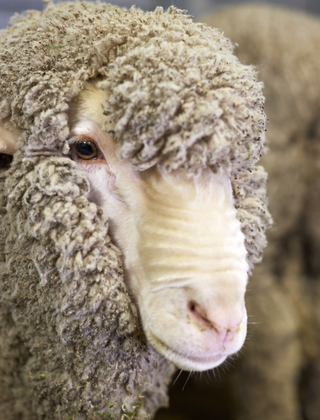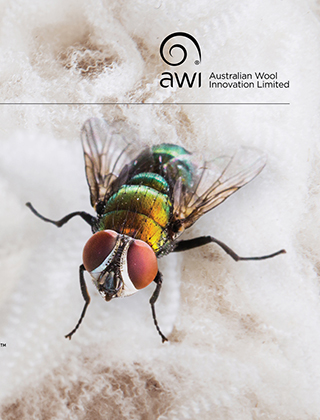AWI adopts new animal health and welfare flystrike prevention policy

Australian Wool Innovation has adopted a new flystrike prevention policy. The new policy supports a scientific fact-based approach to ensure the optimal health, welfare and productivity of Australian sheep, and to ensure they are protected from the risks of disease and death.
AWI acknowledges that the 2010 mulesing 'deadline' is unlikely to be reached for welfare reasons, based on scientific grounds.
AWI warns that pursuing a 'deadline' approach to the phase out of mulesing is not based on sound health and welfare science, and risks a serious deterioration in the welfare of sheep and/or a critical negative impact on the production and supply of wool.
Scientific publications show that without mulesing, the risk of attack of flystrike is 40-100%, and 1-3% with mulesing.1,3
The new policy has been adopted after consultation with woolgrowers, industry representative bodies and other stakeholders. It is based on the scientific evidence regarding the risk of suffering and death from flystrike in the absence of mulesing,1,2,3,4,5 the availability of effective analgesia,6,7 the state of development of alternatives 3,8,9,10,11,12 and the production status of the industry.13,14,15
This evidence has confirmed that sheep in Australia remain highly vulnerable to flystrike due to the Lucilia cuprina blowfly, and that mulesing plays a crucial role to prevent the disease and to support wool production.3,4,5,10,11 There has been progress to remove the need for the procedure through genetic research and breeding 2,3 and the development of alternative methods of breech wrinkle removal 8,9,10,11,12, such as clips and intradermals. Nevertheless, these options are not sufficiently developed to support a wholesale cessation of the procedure in 2010. Breeding strategies will take many years to be fully effective.2,3,8 Clips are now commercially available, but are not suitable for all sheep. An intradermal is in development12. In the meantime there have been significant welfare advances in surgical practice and the development of topical anaesthetics16to allow the procedure (where still needed) to be undertaken with minimal discomfort to lambs and in accordance with acceptable welfare standards for surgical procedures in livestock.6,7
The new policy pursues a step-wise, ethical and sustainable approach to support the safe and successful phase out of the procedure over time as R&D and breeding progresses. AWI's commitment to a fast-tracked R&D program aimed at removing the need for mulesing remains firm. Since 2005, AWI has invested $A20 million on such R&D. In addition, AWI will now also focus on enhancing analgesic options to ensure humane animal care in the interim, including delivery of practical and affordable pre-operative analgesic medications.
AWI will establish a Flystrike Prevention Committee to monitor progress in flystrike control.
The National Wool Declaration enables farmers to declare their wool as either Non-Mulesed (NM), Ceased Mulesed (CM wool comes from farms where farmers no longer practice mulesing) or pain relief treated (PR). AWI will recommend to AWEX that the National Wool Declaration also include a category for wool from clip treated sheep. This provides transparency and choice in the marketplace.
This issue is now fundamentally a transaction between buyer and seller, and will be resolved by the laws of supply and demand. Customers that wish to source non or ceased mulesed wool, as well as wool from sheep treated with pain relief, can do so through the AWEX National Wool Declaration document.
Australian Wool Innovation is a research, development and marketing organisation. It is not empowered to impose any deadline to phase out the practice of mulesing. AWI supports all wool growers in their choice of best practice made in the interests of their animals.
Further information can be obtained by contacting AWI.
Further information about the National Wool Declaration can be obtained by contacting AWEX on +61 3 9318 0277.
References
1. Genetic Alternatives to Mulesing and Tail Docking in Sheep Dr Peter James, Animal Research Institute, Queensland Department of Primary Industries and Fisheries. November 2004 http://www.publish.csiro.au/paper/EA05100.htm
2. Department of Agriculture and Food WA Issue 2 August 2008.
3. Breech Strike Genetics, CSIRO Livestock Industries, Armidale, NSW issue 3 April 2009.
4. Newsletter on the Department of Agriculture and Food Western Australia - Transition to Non Mulesing 3rd edition, Dec 2008. http://www.agric.wa.gov.au/OBJTWR/imported_assets/content/aap/sl/NMN_newsletter_Dec08.pdf
5. Senate Select Committee on Animal Welfare, 1988
6. Lomax S, Sheil M, Windsor P. Impact of topical anaesthesia on pain alleviation and wound healing in lambs after mulesing. Aust Vet J 2008;86:159-168
7. Paull DR, Lee C, Colditz IG, Atkinson SJ, Fisher AD. The effect of a topical anaesthetic formulation, systemic flunixin and carprofen, singly or in combination, on cortisol and behavioural responses of Merino lambs to mulesing. Aust Vet J 2007;85:98-106.
8. Bollen M. Evaluation of an integrated management system for controlling flystrike in the absence of mulesing. http://www.rspca.com.au/about/scholarHAP2005.pdf (Full paper available on request science@rspca.org.au)
9. Hemsworth PH, Barnett JL, Karlen G, Fisher A, Butler K and Arnold N. Effects of mulesing and alternative procedures to mulesing on the behaviour and physiology of lambs. Applied Animal Behaviour Science 2009; 117:1-2,20-27.
10. Evans IB, Lawton PW, Sergeant E, Lloyd JB. The effect of plastic clips used as an alternative to mulesing on breech conformation, bodyweight and survival of Merino lambs. Unpublished 2009 - Preliminary report available from AWI.
11. Allworth B. Further field trials on mulesing and alternative strategies. Proc Aust Sheep Vets Conf 2007:1-6.
12. Cobbett Technologies (unpublished)
13. ABARE Australian Lamb June 2009 http://www.abareconomics.com/interactive/09_SeriesPapers/Lamb/
14. Australian Wool Innovation Production Forecasting Committee, Australian Wool Production Forecast Report. http://www.awta.com.au/en/Home/Statistics/AWPFC/
15. AWEX NWD declared volumes http://www.awex.com.au/market-information/mulesingstatus.html
16. Bayer Animal Health Survey 2008 (n=401, confidence interval /- 4.85%)














